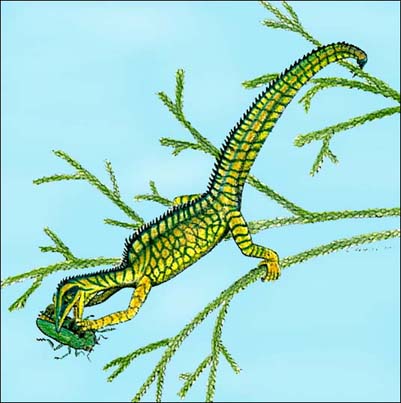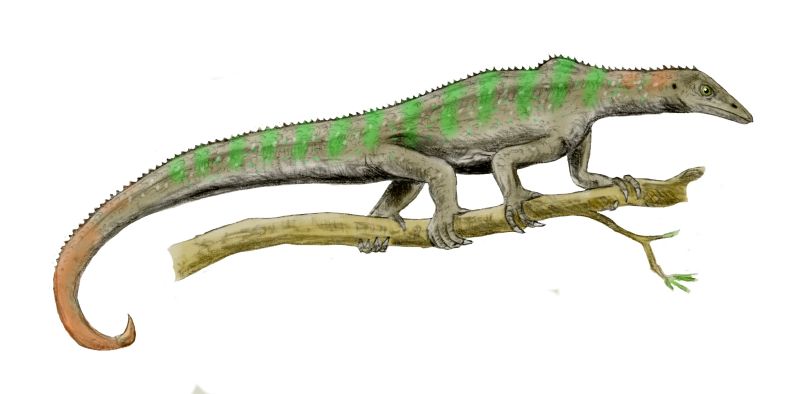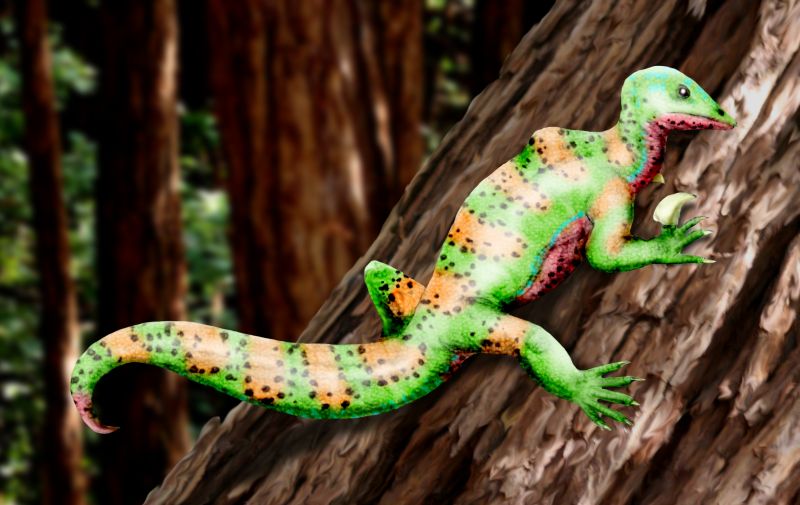Вы не зашли.
Объявление
"Давайте только проявлять больше внимания, терпимости и уважения к чужому мнению — вот и всё." — Gennadius.
— О размещении изображений на форуме, О рекламе на форуме
#1 09 February 2010 17:01:13
- Crazy Zoologist
- Гость
Дрепанозавры
Megalancosaurus.
Hypuronector.
Megalancosaurus.
Drepanosaurus unguicaudatus.
Drepanosaurus.
Vallesaurus.
Monkey-Lizards of the Triassic
The Age of Reptiles (Mesozoic Era) kicked off in grand fashion with the Triassic Period, which began about 250,000,000 years ago and ended about 45,000,000 years later. During the Triassic, reptiles evolved to fill almost every corner of the globe. Plant-eating reptiles munched fronds on vast fern praries, stalked by reptiles who very much wanted to much on them. Reptiles could be found ambushing prey in lakes and rivers, chasing fish in the open ocean, and crushing clams on the sea floor. Reptiles spread membranous wings and flew through the skies. And for a few million years near the end of the Triassic, one strange group of reptiles could be found climbing through the treetops. This group was so well-adapted for an arboreal lifestyle that they have been named the Simiosauria, or Monkey-Lizards.
Megalancosaurus preonensis (Long-armed Lizard from the Preone Valley), pictured above, is one of the best known simiosaurs, and clearly shows some amazing adaptations. It had a bird-like head perched at the end of a flexible neck. A small hump over its shoulders may have served as an attachment point for muscles that could have allowed it to strike at insects and other small prey with lightning speed. Two of the fingers on its hands were in opposition to the other three, allowing it to easily grip branches. Some specimens of Megalancosaurus show a primate-like opposable toe on each rear foot. Other specimens lack this feature, which suggests that it was specific to either males or females (presumably whichever sex needed a stronger grip during mating). Its tail was long and prehensile, and tipped with a sharp claw that might have been useful in securing itself among the branches.
Living alongside Megalancosaurus, was its larger relative, Drepanosaurus unguicaudatus (Claw-tailed Sickle Lizard). Whereas Megalancosaurus was a svelte 25 centimeters long, Drepanosaurus was a stocky half-meter long bruiser. Drepanosaurus is known from only one headless skeleton, with a shoulder hump and clawed, prehensile tail like its smaller cousin. Presumably it would have also had a birdlike beak filled with needle-sharp teeth.
The most striking and unique feature of Drepanosaurus, however, was its forearm. Unlike the slender, grasping limb of Megalancosaurus, Drepanosaurus bore heavily muscled arms and a giant, blade-like claw on its index finger that was almost as large as the rest of its hand. If you look closely at its skeleton, it appears to have an extra bone in its elbow. According to work done by Dr. Silvio Renesto, this bone is the ulna, which in most vertebrates (including us) forms a sort of curved rod that lies alongside the radius down the length of the forearm. But in Drepanosaurus, it is crescent-shaped and curves away from the radius. One of the little bones of the wrist was co-opted into filling the typical role of the ulna, extending from the elbow to the hand. Presumably, this drastic modification of the forearm is related to its massive claw, likely serving as an attachment point for the muscles needed to control such a tool.
At one point, Drepanosaurus was envisioned as a sort of reptilian mole, using its giant claw to dig burrows beneath the ground. But moles and other burrowing animals have very differently shaped claws than Drepanosaurus. The only living animal with a remotely similar hand is the pygmy anteater, which uses one well-developed claw to tear through bark in search of insects. Drepanosaurus likely did the same.
Drepanosaurus was the first Monkey-Lizard to be described, and for this reason the group is frequently referred to as drepanosaurs or drepanosaurids. The term "Simiosauria" was coined by Phil Sentor in 2004, who reserved the term drepanosaur for the three most closely related members of the group (Drepanosaurus, Megalancosaurus, and Dolabrosaurus (below)).
Drepanosaurus and Megalancosaurus are known from northern Italy, which during the Triassic was a tropical coast. The fine-grained sediments that collected there preserved many unusual reptiles including three different types of Monkey-Lizard: the two mentioned above and a much smaller relative known from a single, 15 cm long skeleton. This skeleton has been referred to as "Vallesaurus" but is not yet officially described.
Moving across the Atlantic Ocean, which was just a wide valley in the Late Triassic, we find a couple of different Monkey-Lizards on the modern continent of North America.
Megalancosaurus.
Skeleton of Megalancosaurus preonensis, modified from Renesto 1994b.
Skeleton of Drepanosaurus unguicaudatus, modified from Renesto 1994a. Neck and head are based on Megalancosaurus.
Sketch of Drepanosaurus marvelling at its unusual hand.
The head is completely speculative.
#2 09 February 2010 20:29:07
- Arctodus-simus
- Модератор

- Откуда: Лукаморье
- Зарегистрирован: 15 October 2007
- Сообщений: 16362
Re: Дрепанозавры
Это вообще странные существа. Они, кстати, разве не в архозаврах?
Doctrina multiplex , veritas una !
Неактивен
#3 09 February 2010 20:51:46
- Crazy Zoologist
- Гость
Re: Дрепанозавры
Они близкие родичи лонгисквамы, а она не в архозаврах.
#4 24 March 2011 22:57:52
- Unenlagia
- Администратор

- Откуда: Серпухов
- Зарегистрирован: 04 November 2008
- Сообщений: 4591
Re: Дрепанозавры
Отредактировано Unenlagia (24 March 2011 23:00:01)
Не волим змајеве, али чини ми се да су ме воле!
Неактивен
#5 11 December 2011 21:56:12
Re: Дрепанозавры
Огромное спасибо Коту за инфу по дрепанозавридам. Экая экзотика, перерыл всю сеть по поводу киргиззавра, а толку чуть. Круто, что тут хоть немного есть!
Свидетельствую свое совершеннейшее почтение!
Неактивен
#6 11 December 2011 22:09:27
- Левша
- Любитель животных

- Зарегистрирован: 19 December 2010
- Сообщений: 709
Re: Дрепанозавры
Загрузка рисунков http://savepic.net/index.php
Неактивен
#7 11 December 2011 22:24:48
- Unenlagia
- Администратор

- Откуда: Серпухов
- Зарегистрирован: 04 November 2008
- Сообщений: 4591
Re: Дрепанозавры
Новая рептилия Kyrgyzsaurus bukhanchenkoi gen. et sp. nov., из триаса (мадыгенской свиты) юго-запада Кыргызстана, описана по передней части скелета (череп, шейные и передние спинные позвонки, рёбра, грудной пояс) и отпечаткам кожи. Это самый архаичный представитель семейства Drepanosauridae (Archosauromorpha, Diapsida). Самые яркие черты новой формы - укороченная нижняя челюсть, многочисленные зубы, гранулированное тело остеодерм, крупные выступообразные надглазничные кожные складки, а также толстый и широкий горловой мешок.
PS: Пока резюме на русском писал, саму статью уже выложили. ![]()
Отредактировано Unenlagia (12 December 2011 01:44:05)
Не волим змајеве, али чини ми се да су ме воле!
Неактивен
#8 11 December 2011 22:30:29
#9 11 December 2011 22:38:28
- Unenlagia
- Администратор

- Откуда: Серпухов
- Зарегистрирован: 04 November 2008
- Сообщений: 4591
Re: Дрепанозавры
Сань, зачем? Какая разница, кто её выложил.
Оффтоп:
Митрич, не хотите перевести эту статейку? На русском её, как я понимаю, вообще днём с огнём не найти. А то я сейчас занят переводом Gobisaurus domoculus, а потом и Epidexipteryx в планах.
Отредактировано Unenlagia (11 December 2011 22:45:31)
Не волим змајеве, али чини ми се да су ме воле!
Неактивен
#10 12 December 2011 10:54:31
Re: Дрепанозавры
Unenlagia :
Митрич, не хотите перевести эту статейку? На русском её, как я понимаю, вообще днём с огнём не найти.
Да я, собственно, новость уже отписал. А переводы монографий - не мой профиль, больно уж специальная тема.
Свидетельствую свое совершеннейшее почтение!
Неактивен
#11 17 May 2012 05:04:51
- Crazy Zoologist
- Гость
Re: Дрепанозавры
#12 17 May 2012 18:02:26
- Звероящер
- Модератор

- Откуда: Фрязино, Московская обл.
- Зарегистрирован: 13 April 2007
- Сообщений: 14912
Re: Дрепанозавры
Gorgonopsid :
Это весьма необычное существо, кстати, умело планировать.
Вообще-то нет. Ни один из дрепанозавров не имеет адаптаций к планирующему полёту. Все они, за исключением Hypuronector (образ жизни которого не совсем ясен), явно древесные формы, несколько напоминающие хамелеонов.
Life is short, but snakes are long...
Неактивен
#14 17 May 2012 22:15:35
- Crazy Zoologist
- Гость
Re: Дрепанозавры
Современная зеленая игуана - древесное существо, которое во время опасности спрыгивает с ветвей в воду и при этом отлично плавает. Возможно Hypuronector вел сходий образ жизни, но не с древесным уклоном как игуана, а наоборот с водным.
#15 17 May 2012 22:35:23
- Звероящер
- Модератор

- Откуда: Фрязино, Московская обл.
- Зарегистрирован: 13 April 2007
- Сообщений: 14912
Re: Дрепанозавры
Avtograf :
Может они для терморегуляции?
Как правило, различные паруса и прочие приспособления для терморегуляции среди пойкилотермных развиваются у крупных форм. У мелких животных, помимо их размера, площадь поверхности тела относительно больше. Поэтому нагреваются и охлаждаются они и так быстро, дополнительное увеличение поверхности конкретно для терморегуляции по сути будет бесполезно: оно даст либо очень маленькие преимущества, либо вообще их не даст (возможно, наоборот, будет во вред).
Life is short, but snakes are long...
Неактивен

